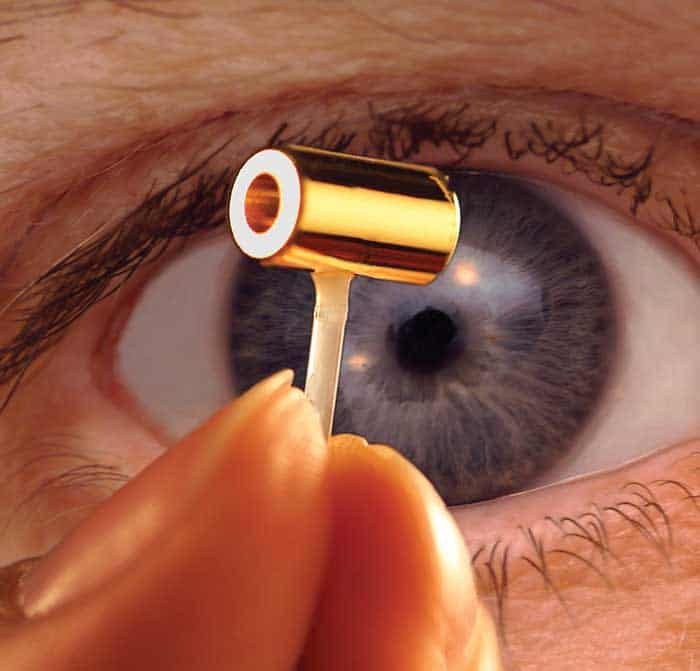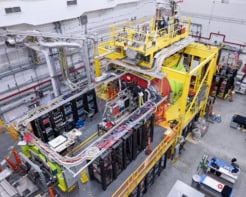The “break-even” point of inertial confinement fusion remains elusive, but slow and steady progress may yet win the race, as Margaret Harris reports

In an alternative universe, the quest for fusion energy passed a major milestone sometime in the closing months of 2012. That was the year scientists at the US National Ignition Facility (NIF) conducted a high-profile campaign to achieve the facility’s central purpose: ignition, a controlled nuclear fusion reaction that produces more energy than is required to sustain it. Reaching this point would have capped decades of research on inertial confinement fusion (ICF), which uses lasers or magnetic fields to heat and compress nuclear fuel to high temperatures and pressures. Ignition would also have been something of a vindication for NIF itself, banishing memories of the construction delays and cost overruns that plagued the multibillion-dollar laser before it opened at the Lawrence Livermore National Laboratory (LLNL) in 2009.
Early in 2012, leaders of NIF’s so-called “National Ignition Campaign” felt they had reasons to be optimistic. Computer models predicted that at laser energies of around 1.7 MJ, the tiny capsule of deuterium-tritium fuel at the heart of the NIF target chamber would begin releasing neutrons and alpha particles in unprecedented numbers, ushering in the conditions required for ignition. NIF was designed to deliver 1.8 MJ. Surely, ignition was just around the corner.
It wasn’t. In the real universe, the National Ignition Campaign ended with a whimper, not a bang. The reasons for the failure were manifold. In mid-2016 the National Nuclear Security Administration (NNSA) published a review describing them in detail. Computer codes and models predicting high energy gain from the fuel capsules were “not capturing the necessary physics”, the review’s authors wrote. Experimental efforts were “frustrated by the inability to distinguish key differences” between laser shots, with similar set-ups producing scattered results. Most damningly, the review cited a “failed approach to scientific program management” based on “circumvent[ing] problems rather than understanding and addressing them directly”. As the report’s authors concluded, “The question is if the NIF will be able to reach ignition in its current configuration and not when it will occur.”
Omar Hurricane, chief scientist in NIF’s inertial confinement fusion programme, is frank in his assessment of the failed campaign. “It was kind of like trying to swing for a home run and missing,” he says. A soft-spoken, pragmatic physicist who was working elsewhere within LLNL at the time, Hurricane explains that success would have required “an incredible amount of control” over many different parameters.
Chain of events
Consider the chain of events that must happen before ignition can occur at NIF. During a shot, the combined energy of the facility’s 192 laser beams is directed onto a hollow target about one centimetre in height and a few millimetres in diameter. This target, known as a hohlraum, contains helium gas, and at its centre is a tiny capsule filled with deuterium–tritium fuel. As the lasers heat the hohlraum, the gold coating on its interior surface begins to give off X-rays. These X-rays bathe the fuel capsule with radiation, heating it and causing material on the outside of the capsule to rocket off at speeds of hundreds of kilometres per second. Momentum conservation then forces the rest of the capsule to implode, and if the density and temperature of the imploding capsule become high enough the deuterium and tritium nuclei will fuse. “The idea for ignition is that we can actually get a propagating burn wave in the target – ‘lighting a match’ that can burn spherically outward and release more fusion energy than we put in to get it started,” NIF director Mark Herrmann explains.
The key to making that happen – and the reason it hasn’t yet – can be summed up in a single word: symmetry. The laser field outside the hohlraum is not perfectly symmetric. Neither is the X-ray field produced inside. Wherever such asymmetries exist, the pressure applied to the fuel capsule is slightly different. “You can think of it as like trying to squeeze a soccer ball down to something the size of a pea,” Herrmann says. “If you squeeze harder on one side or another you get a lima bean, or a string bean. You don’t get a pea.”

One notable cause of asymmetric “squeezing” is a phenomenon known as cross-beam energy transfer (CBET). When laser beams overlap in the presence of a plasma, one beam can, in effect, “steal” energy from another. “You think you’ve designed the laser illumination pattern to give you a symmetric drive, and the beams kind of conspire to change that for you,” explains Warren Garbett, a plasma physicist at the UK’s Atomic Weapons Establishment who has served on review panels for ICF research. As well as creating asymmetries, CBET can also divert energy from an incoming beam to an outgoing one. Such processes are “very difficult to predict, and also very difficult to control”, says Jerry Chittenden, a plasma physicist at Imperial College London and a co-author on the NNSA report. “It’s a bit like in the film Ghostbusters: bad things happen when the beams cross.”
The behaviour of fuel capsules under pressure is also tricky to control. As weak spots in the capsule begin to give way, material flows away from them. This distorts the capsule and can even tear it to pieces before fusion has a chance to get started. The process that turns small fluid asymmetries into big ones is known as a Rayleigh–Taylor instability, and Hurricane notes that its relevance has been understood since the early days of ICF research. What wasn’t understood, he adds with a wry smile, was just how much of a barrier it would prove.
Seeking symmetry
Since the end of the ignition campaign, research at NIF has shifted away from trying to achieve ignition directly. Instead, the focus is on understanding sources of asymmetry in capsule implosions and finding ways to minimize them. One key development was to put slightly more energy into the beginning, or “foot”, of the laser pulse. The resulting implosions are less prone to Rayleigh–Taylor instabilities, and in 2014 the “high-foot” campaign reported a notable success: more energy was produced through fusion than was applied to the fuel. “This is open to interpretation, but the results seem to indicate that the ignition process is at least starting,” Chittenden says. In some experiments, he points out that the pressure at the hottest point in the deuterium–tritium fuel came within a factor of two of the value required for ignition. Unfortunately, heating the capsule more at the beginning of the pulse makes it harder to compress later, so in effect, the high-foot strategy trades greater implosion symmetry for reduced maximum pressure. Maximizing the energy yield from a shot will therefore require a change of tactics.
As the high-foot design and other modifications have improved the symmetry of capsule implosions, other causes of asymmetries have emerged. One culprit is the gossamer-fine membrane that holds the fuel capsule in place inside the hohlraum. Recent experiments have shown that as X-rays hit this tent-like structure, it explodes, creating a pulse of pressure at the point where material strikes the fuel capsule. Another source of asymmetry is the tiny glass tube used to fill the capsule with fuel. Although the tube is only about 10 µm in diameter, Hurricane says they can still see its effects in their data. Fixing these problems will likely involve a combination of engineering and physics, with engineers working to make the tent and fill tube less intrusive while physicists search for ways of compensating for their effects. “It’s a systematic process,” Hurricane says. “We’re digging deeper and deeper into the implosion. Every time we do that, we see an improvement, but there’s also the chance of seeing yet another problem. We’re just trying to knock them off one at a time.”
Other labs, other prospects
Between now and 2020, the plan is for researchers at NIF to map out the effects of different laser pulse shapes; different densities of helium gas inside the hohlraum; and new materials for both hohlraum and fuel capsule. The goal, as defined in the NNSA’s latest framework for inertial confinement fusion research, is “to determine the efficacy of NIF to achieve ignition and, if this is found to be improbable, to understand the reasons why”.
If the answer turns out to be negative, one possible way forward would be to reconfigure NIF so that its lasers heat fuel capsules directly, rather than via a hohlraum. Cutting out the intermediate step would increase the energy applied to the capsule by a factor of 10, albeit at the probable cost of increased CBET and other laser-related sources of instability. Experiments on this “laser-driven direct drive” method are currently under way both at NIF and at smaller-scale laser facilities such as the University of Rochester’s Laboratory for Laser Energetics (LLE). Converting NIF to direct drive is “something we’re considering”, Hurricane says, but he adds that doing so would require new funding, since NIF’s lasers are not designed to produce a spherically symmetric laser field. Also, with current technology, results at the LLE suggest that direct-drive fusion experiments at a NIF-scale facility would come within a factor of two of the pressures required for ignition. This, as Chittenden points out, is similar to what NIF can do already.
Meanwhile, scientists in France are watching NIF’s progress with interest. The design of the Laser Mégajoule (LMJ) facility near Bordeaux is similar to NIF’s – Jean-Luc Miquel, programme leader for laser-plasma experiments at the LMJ, calls them “brother lasers” – and it will be capable of similar energies once it is fully operational. Currently, only 16 of the LMJ’s planned 176 beams are in use, with an additional 40 scheduled to come online by 2019. The final completion date will be sometime at the beginning of the next decade, with government funding and the needs of the French nuclear-weapons programme dictating the pace of progress. (Both the LMJ and NIF perform experiments on weapons physics in addition to ICF research, and the French programme draws little distinction between the two.) Currently, work at the LMJ is focused on lower-energy studies of hohlraum energetics, radiation transport and hydrodynamic instabilities, with more topics to be added as additional beams become available. “For us, ignition is the ultimate goal of the LMJ, but there is a lot of physics that can be addressed before then,” Miquel says.
At other laboratories, ignition is even further away. A variant of ICF that uses magnetic fields to compress fuel is being pursued at the Sandia National Laboratory in New Mexico, but reaching ignition via this method would probably require a next-generation facility. An alternative laser-based approach, known as “fast ignition”, is being studied at the LLE and at Osaka University in Japan, with larger facilities planned that would determine whether promising results at low energies translate into ignition at high energies. Plans for even bigger lasers, on the 3–4 MJ scale, have also been put forward in both Russia and China. So far, however, these facilities exist only on paper.
For the moment, NIF remains the world’s best hope for ignition, and while the fevered expectations of 2012 have dissipated like a vaporized hohlraum, there is plenty of optimism left within the ICF community. “Looking at the history of ICF, quite often facilities have been built expecting to get ignition, and then more physics has been discovered, and they find out they are some way away,” Garbett says. “But NIF is really on the cusp.” In his own calm, deliberate way, Hurricane is also upbeat. “The fact that we can actually see problems that we have a chance of fixing gives me hope that we can make progress,” he says. “That’s a much better situation to be in than ‘It’s still not working, we can’t see anything wrong, and we don’t know what to do about it.’ It’s not going to be easy, it’s going to be a lot of work, and we’re going to have to fight for every bit of progress. But scientists like solving problems – it’s part of the job.”



